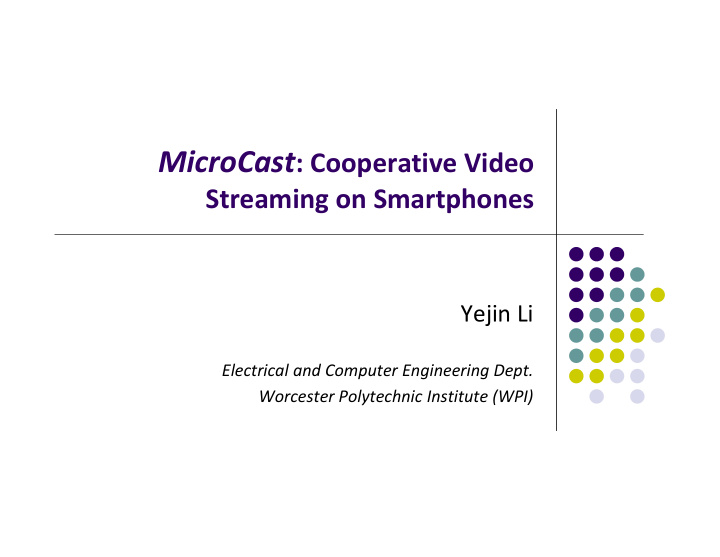



MicroCast : Cooperative Video Streaming on Smartphones Yejin Li Electrical and Computer Engineering Dept. Worcester Polytechnic Institute (WPI)
Motivation A group of smartphone users who are interested in watching the same video from the Internet at the same time.
Solution— MicroCast Each phone uses simultaneously two network interfaces: One (cellular) to connect to the video server; Another (WiFi) to connect to the rest of the group.
Related Work Co ‐ operation between mobile devices. New feature in Android 4.0——provides P2P connectivity using WiFi Direct. Network coding for P2P system.
Architecture MicroCast = MicroDownload MicroNC ‐ P2 MicroBroadcast
MicroDownload The video is divided into segments of fixed size. the next segment to be downloaded is assigned to a phone which has the smallest backlog .
MicroNC ‐ P2 A novel all ‐ to ‐ all dissemination scheme for locally sharing content among group members within proximity of each other. It leverages the combination of network coding and WiFi overhearing
Test Environment four Samsung Captivate and three Nexus S. All smartphones have a 1 Ghz Cortex ‐ A8 CPU and 512 MB RAM. Six of them use Android Gingerbread (2.3) and one (Nexus S) uses Android Ice Scream Sandwich (4.0) as their operating systems.
Video Demo
Evaluation—MicroDownload Disabled MicroNC ‐ P2, the download rates of the smartphones over 100 seconds. Phone 1, 2—3G; Phone 3—EDGE
Evaluation—MicroNC ‐ P2 The amount of local traffic using different distributors. The file is 9.93 MB.
Evaluation — MicroCast System Average download rate as a function of number of phones when the local network bandwidth is 20 Mbps vs. 4Mbps. Only first 4 phones had 3G connection.
Evaluation — Battery Consumption 3 phones connected to a 4 th phone as AP , the 3G rates vary from 450 Kbps to 700 Kbps, and video size is 95.4 MB. Local network Disabled.
Discussion and conclusions the current implementation can support no more than 7 concurrent devices (when an Android 4.0 device acts as the AP) or 6 devices (when an Android 2.3 device acts as the AP). MicroCast cooperatively uses the resources on all smartphones of the group, such as cellular links and WiFi connections, to improve the streaming experience.
References Wireless network coding: from theory to practice, project wiki ‐ page. http://odysseas.calit2.uci.edu/doku.php/public:muri09
Thank You!
Recommend
More recommend